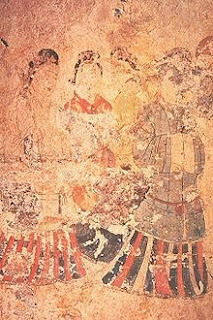The Chinese pyramids are ancient mausoleums and burial mounds built to house the remains of several emperors of China and their imperial relatives. About 38 of them are located around 25 kilometres (16 mi) - 35 kilometres (22 mi) north-west of Xi'an, on the Qin Chuan Plains in Shaanxi Province. The most famous is the Mausoleum of the First Qin Emperor, northeast of Xi'an and 1.7 km west of where the Terracotta Warriors were found. Chinese pyramids were also built during the Han, Tang, Song, and Western Xia dynasties.
Google Earth clearly shows many of them and includes Panoramio photographs of many. They have flat tops, and thus are more similar in shape to the Teotihuacan pyramids north-east of Mexico City, Mexico than to the pyramids in Giza, Egypt. Although known in the West for at least a century, their existence has been made controversial by sensationalist publicity and the problems of Chinese archaeology in early 20th century.
Recognition in the West
The introduction of pyramids in China to popular attention came in two stages. Many early stories were focused on the existence of "Great White Pyramid." U.S. Army Air Corps pilot James Gaussman is said to have seen a white jewel-topped pyramid during a flight between India and China during World War II. Colonel Maurice Sheahan, Far Eastern director of Trans World Airlines, told an eyewitness account of his encounter with a pyramid in the March 28, 1947 edition of The New York Times. A photo of Sheahan's pyramid appeared in The New York Sunday News on March 30, 1947. This photograph later became attributed to James Gaussman. Chris Maier showed that the pyramid in the photo is the Maoling Mausoleum of Emperor Wu of Han, just outside of Xi'an. Alternative writers such as Hartwig Hausdorf (who speculated it was built by aliens) and Phillip Coppens did much to bring them to public attention.
Despite claims to the contrary, the existence of these pyramid-shaped tomb mounds was known by scientists in the West before the publicity caused by the story in 1947. Shortly after the New York Times story, Science News Letter (now Science News) published a short item saying "The Chinese pyramids of that region are built of mud and dirt and are more like mounds than the pyramids of Egypt, and the region is little travelled. American scientists who have been in the area suggest that the height of 1,000 feet (300 m), more than twice as high as any of the Egyptian pyramids, may have been exaggerated, because most of the Chinese mounds of that area are built relatively low. The location, reported 40 miles (64 km) southwest of Sian, is in an area of great archaeological importance, but few of the pyramids have ever been explored." Victor Segalen visited China in 1913 and wrote about the First Emperor's tomb (and other mound tombs in the region) in Mission Archeologique en Chine (1914): L'art funeraire a l'epoque des Han.
Some of the pyramids of Xi'an are now tourist attractions and several pyramids have small museums attached to them.
The Development of Mound Tombs in China
There is a long history of building mounded tombs in China, dating back to at least the Shang-Zhou period.
Partial list of Chinese pyramids
- Maoling Mausoleum 1: 34°20′17″N 108°34′11″E / 34.3380854°N 108.569684°E
- Pyramid 6: 34°21′47″N 108°37′50″E / 34.363135°N 108.63053834°E
- Pyramid 7: 34°21′42″N 108°38′24″E / 34.3617534°N 108.6401081°E
- Pyramid 11: 34°22′30″N 108°41′53″E / 34.3748955°N 108.6980009°E
- Pyramid 15: 34°23′52″N 108°42′45″E / 34.3977741°N 108.7124205°E
- Pyramid 31: 34°14′09″N 109°07′07″E / 34.2358251°N 109.1186142°E
- Pyramids 33,34,35: 34°10′52″N 109°01′20″E / 34.1810627°N 109.0223122°E
- Huang-ti Mausoleum 37: 34°22′52″N 109°15′14″E / 34.3812356°N 109.2540121°E
- Shaohao's tomb, 少昊陵.
- Mount Li mausoleum (or Qin Shi Huang mausoleum, 驪山陵, 秦始皇陵) is the largest Chinese pyramid. The original height is 76 metres (249 ft), the present height is 47 metres (154 ft), and the size is 357 metres (1,171 ft) x 354 metres (1,161 ft). It was built during the short-lived imperial Qin Dynasty (221-206 BC).
- Maoling mausoleum (or Great White Pyramid, 茂陵) is the second largest Chinese pyramid. The size is 222 metres (728 ft) x 217 metres (712 ft). It contains the tombs of emperor Wudi (156-87 BCE) of the Han Dynasty (206 BC - 220 AD) and some family members and proteges.
- Inner Mongolian pyramid, situated about 1 km (0.62 mi) north of Sijiazi (四家子) Town, Aohan County (敖漢旗), vestige of the Hongshan culture. The site of Niuheliang contains a pyramidal structure too.
- Yangling mausoleum contains the tomb of Wudi's father, Jingdi.
- The eighteen mausoleums of the Tang Dynasty emperors (唐十八陵) in the valley of the Wei River north of the Qinling Mountains(秦岭). Some are among the biggest Chinese mausoleums, such as Qianling (乾陵), joint tomb of Emperor Gaozong of Tang and of the Empress Wu Zetian. It is a natural hill shaped by man.
- Janggun-chong (Jiangjunzhong 將軍塚) Step Pyramid in Jilin, "Tomb of the General", is supposed to be the mausoleum of King Jangsu (Ko. 장수왕 Ch. 長壽王) (413-491), king of Goguryeo, an ancient Korean kingdom. It belongs to the Capital Cities and Tombs of the Ancient Koguryo Kingdom on the World heritage list. Nearby is the Taewang-neung / Taiwangling (태왕릉, 太王陵) Pyramid believed to be the burial of King Gwanggaeto the Great (Ko. 광개토태왕; Ch. 廣開土太王) (391-413); while twice bigger than Janggun-chong, it is in bad shape and Janggun-chong is touted as the touristic highpoint of the site.
- The Western Xia tombs of the Tangut Empire near Yinchuan in Ningxia Hui Autonomous Region, northwestern China, a large number of tombs covering some 50 km2 (19 sq mi) are referred to as 'Chinese Pyramids'.
from: http://en.wikipedia.org/wiki/Chinese_pyramids
















